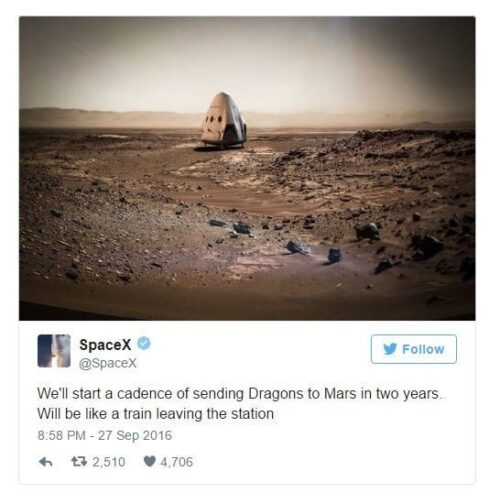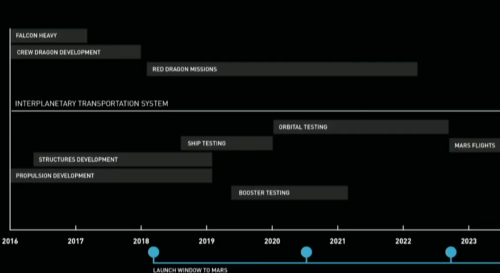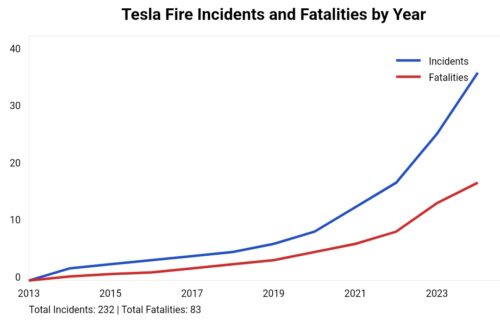Oh how time flies.

So many things he said that were so wrong then, and even more wrong now…
“So if the person and their luggage, life support, and consumption” is accounted for, he said, “ultimately it could drop below $100,000.” A trip to Mars on ITS would take about 80 days. […] Musk wants the trips to Mars to be yearly, if not more frequently, and to start colonization in 2022
I mean the 2016 SpaceX money slide called “Next Steps” promised investors that Mars travel would be all done and dusted by 2024, 30 day rides at $100K.

Why are we even still here on earth?
In 2017 he doubled down on the pitch.
SpaceX’s previous plan called for landing its first transport ship on Mars in 2022. The timeline Musk gave today was similar; two cargo landers would land on Mars in 2022, with four vehicles launching in 2024. Two of those 2024 ships would be crewed, meaning, in Musk’s timeline, humans could walk on Mars in just seven years.
“That’s not a typo,” he said.
Not a typo he said, meaning Elon Musk wanted everyone to know his entire reputation should be based on him putting a man on Mars by 2024.
You may also remember 2013 when he laid out these numbers:
Musk envisages a colony with 80,000 people on the red planet.
Of course that didn’t sound preposterous enough, so a couple years later he was puffing even harder.
Musk says a sustainable colony of 1 million people could be established in about 40 to 100 years.
His sudden escalation from 80,000 to 1 million colonists seems to follow a pattern common in financial bubbles. When initial ambitious claims fail to materialize, even more extreme promises are made to maintain attention and investment. This mirrors tactics seen in other ventures where missing deadlines leads to even grander future predictions rather than realistic reassessment.
What’s driving all this nonsense? A misunderstanding about regulations.
…recognize Mars as a free planet and that no Earth-based government has authority or sovereignty over Martian activities. Accordingly, Disputes will be settled through self-governing principles, established in good faith, at the time of Martian settlement.
It’s hard to believe Musk actually gets away with statements of this nature.
“It should probably be easier to remove a law than create one,” said Musk. “I think that’s probably good, because laws have infinite life unless they’re taken away.”
Apparently that’s not how anything actually works. It’s so dumb as to be painful to think about. Laws are the opposite to what is described, because they are:
- Amended and modified through legislative processes
- Interpreted and reinterpreted through court decisions
- Superseded by newer laws
- Limited or expanded in scope through regulatory implementation
- Rendered obsolete by changing circumstances
- Preempted by higher authorities (e.g., federal law over state law)
- Struck down as unconstitutional
- Sunsetted or automatically expired based on built-in provisions
Making laws “easier to remove than create” and Mars being free from “Earth-based government” authority suggest an attempt to frame space exploration in terms of escaping public oversight rather than serving public interests… but I’m not a lawyer.
I do know however that NASA safely landed two drones on Mars (Spirit and Opportunity) in January 2004 and this guy can’t even get one ship there by 2024 to declare his caliphate of Martian law.
Not a typo.
Public NASA missions succeeded 20 years ago using technology far less advanced than what’s available today. Yet even with modern advantages, basic milestones of private Mars exploration remain unmet and far away. This suggests the core challenges aren’t primarily technical but rather stem from the fundamental mismatch of grifters, between public relations promises and physical/economic realities.
NASA’s successful missions, built on careful scientific research and public accountability, stand in stark contrast to the extremely wasteful, bombastic but undelivered private sector promises.
More to the point, he sucks at delivering on his most basic promises that are only a couple or few years into the future. Why does anyone think he could deliver something even further away and more sophisticated?
Even worse, “free planet” rhetoric reveals the fundamental contradiction behind the fraud. Claiming independence from Earth governance hides how these private space ventures remain heavily dependent on public sector research, funding, and infrastructure. Such extremist anti-government political framing of space exploration often obscures its reliance on collective public investment and institutional knowledge.
Perhaps it’s time for accountability in private space ventures, reviewing how public resources and attention get directed based on false promises and fantasy schemes rather than demonstrated capabilities. The real damage isn’t just wasted resources, it’s a targeted erosion of public trust and diversion away from actual scientific progress to publicity-driven fantasies.
The Mars colony promises really are a reflection of other ventures like the Hyperloop and Tesla’s self-driving capabilities.
- Hyperloop (2013): LA to SF in 35 minutes by 2020, tickets under $30
- Full Self-Driving (2016): Coast-to-coast autonomous drive by 2017
- Mars Colony (2016): First humans by 2022, million-person colony in 40 years
This totally unhinged snake-oil salesman nonsense has actually harmed legitimate technology development by creating unrealistic public expectations, diverting resources from methodical scientific approaches, undermining trust, promoting a false narrative about private sector efficiency.
The pattern is consistent: announce extremely aggressive timelines, miss them completely, then make even grander promises rather than acknowledge the original overreach. The timeline above should be particularly damning in how it shows escalation rather than learning.

